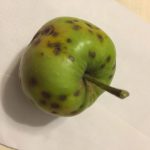I have Apple,Pear,Cherry and grape vines.They all get infected early in the spring with black spot,scab…? The leaves on the pears get spots they later turn brown and entire branches die out.the leaves on the grape vine they grow clasters of little thin tets and they look seak.
I’m attaching some pictures from last year, thanks for your help
Thank you for contacting the Toronto Master Gardeners regarding the infestation in your fruit garden.
Judging from the photograph of the apple, your trees seem to be infected by apple scab (the fungus Venturia inaequalis). Once a plant has been infected, the fungi overwinter and reproduce within the infected leaves on the ground; maturation of the spores usually coincide with the apple trees breaking dormancy, thus readily infecting the first green tissues via rain and wind. This is the primary infection. Secondary infections then occur through the growing season, with several cycles of infection possible if there is frequent rainfall. Therefore, the first step in managing this (and all fungal) disease is thorough removal of all infected plant materials in the fall. Throw them away—do not compost. Fungicides are used in commercial orchards to prevent and control severe infestations, but options for home gardens are limited to copper- and sulphur-based ones. These are readily available at nurseries and garden centres.
The symptom of entire branches dying, however, points to another possible culprit—fire blight (the bacterium Erwinia amylovora). Fire blight can infect all parts of a tree, not just leaves and fruits. Bacteria overwinter at the edges of cankers; thus infected plant materials must be removed to prevent further infection. Take a look this is Ontario Ministry of Agriculture, Good and Rural Affairs (OMAFRA) article on fire blight to determine if your trees are in fact infected, and for further guidance on management.
Lastly, it seems that your grapes are ailed by something else all together. I cannot offer a diagnosis without a photograph or a more detailed description of the symptoms, but please refer to this OMAFRA article on grape diseases and disorders for help in determining the problem.
We wish you the best of luck in managing the diseases and a bountiful harvest this year.


